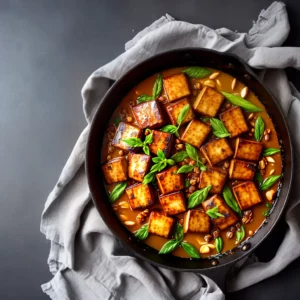How to Freeze Broccoli
Freezing broccoli is an easy and effective way to extend its shelf life and enjoy this nutritious vegetable year-round. By following these simple steps, you can preserve the freshness and flavor of your broccoli, ensuring it remains a healthy addition to your meals.
To begin, start by cutting the broccoli into florets. These small, bite-sized pieces are ideal for freezing and using in various recipes. Once you have your florets ready, blanch them in boiling water for 1 to 2 minutes. This process helps retain the vibrant color and crispness of the broccoli.
After blanching, quickly rinse the florets under cold water to cool them down and stop the cooking process. It’s important to cool them rapidly to preserve their texture and prevent them from becoming mushy. Pat the broccoli dry using a clean kitchen towel or paper towels.
Next, spread the blanched and dried florets in a single layer on a baking sheet. This allows the broccoli to freeze individually, preventing it from clumping together. Place the baking sheet in the freezer for about 1 hour or until the florets are firm and frozen.
Once the broccoli is frozen, transfer the florets to a sealable freezer-safe bag. Make sure to remove any excess air from the bag before sealing it tightly. Label the bag with the date of freezing to keep track of its freshness. Frozen broccoli can be stored in the freezer for 6 to 8 months.
When using frozen broccoli in recipes, it’s important to note that it may require slightly less cooking time than fresh broccoli. Cook the frozen florets slightly less than the recipe indicates for fresh broccoli to avoid overcooking. The frozen broccoli can be added directly to recipes without the need for thawing beforehand.
How to Freeze Broccoli – Key Takeaways:
- Freezing broccoli is a simple and effective method of preserving its freshness.
- Cut the broccoli into florets and blanch them in boiling water for 1 to 2 minutes.
- Rinse the blanched florets under cold water to cool them down.
- Dry the broccoli thoroughly before freezing it on a baking sheet.
- Transfer the frozen broccoli to a sealable freezer-safe bag and store it for 6 to 8 months.
- Cook frozen broccoli slightly less than the recipe indicates for fresh broccoli.
- Frozen broccoli can be used directly in recipes without the need for thawing.
Why Freeze Broccoli?
Freezing broccoli offers several advantages, including preserving its nutritional value and ensuring availability even when fresh broccoli isn’t readily accessible. By freezing broccoli, you can enjoy the benefits of this healthy vegetable throughout the year, without worrying about it spoiling or going out of season.
One of the main benefits of freezing broccoli is the preservation of its nutritional content. Broccoli is rich in essential vitamins, minerals, and antioxidants that support overall health and well-being. Freezing broccoli helps to retain these nutrients, allowing you to enjoy the same health benefits as fresh broccoli even after it has been stored in the freezer.
Another advantage of freezing broccoli is its convenience. When fresh broccoli is not in season or easily available, having frozen broccoli on hand allows you to incorporate this versatile vegetable into your meals whenever you desire. Whether you’re making stir-fries, soups, casseroles, or side dishes, frozen broccoli can be a convenient and nutritious addition to various recipes.
To freeze broccoli properly, follow the step-by-step guide outlined in this article. By cutting the broccoli into florets, blanching them, and freezing them in a single layer before transferring them to a freezer-safe bag, you can ensure the quality and freshness of the frozen broccoli for up to 6 to 8 months. When using frozen broccoli in recipes, it’s best to cook it slightly less than the recipe indicates for fresh broccoli.
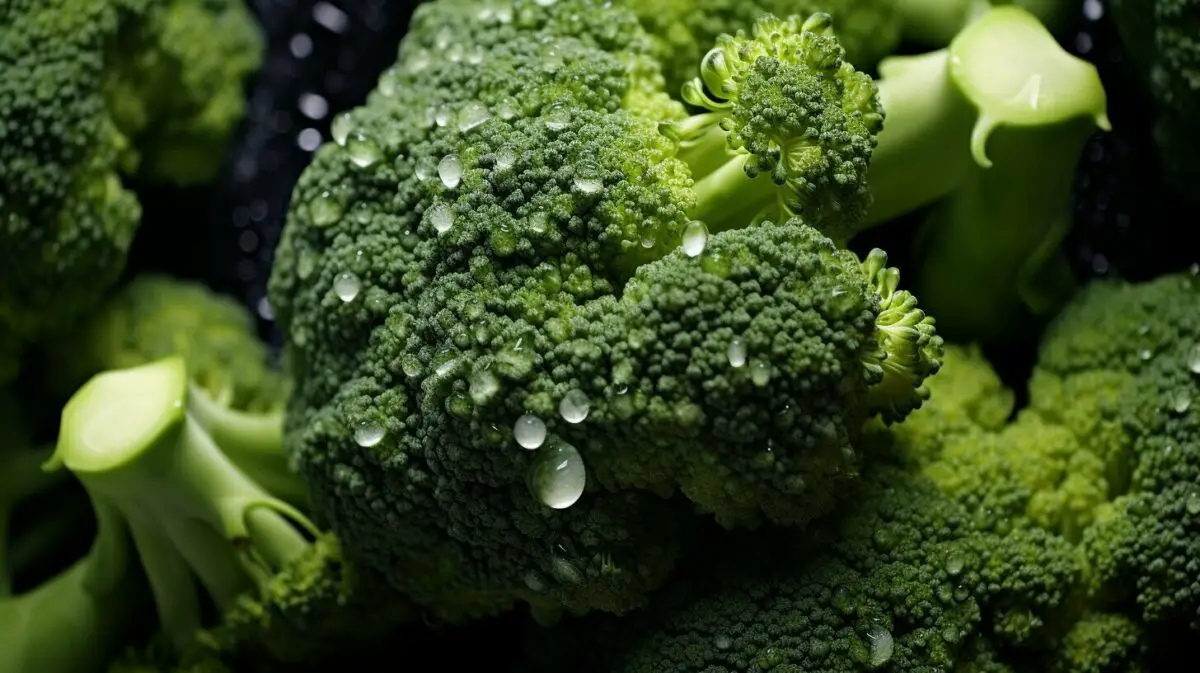
| Advantages | Explanation |
|---|---|
| Preserves Nutritional Value | Freezing broccoli helps retain its essential vitamins, minerals, and antioxidants. |
| Extended Availability | Frozen broccoli ensures you have access to this nutritious vegetable even when it’s out of season or not readily available. |
| Convenience | Frozen broccoli can be conveniently used in various recipes, making meal preparation easier and more efficient. |
| Reduced Food Waste | Freezing broccoli allows you to preserve excess or unused portions, reducing food waste. |
Preparing Broccoli for Freezing
Before freezing broccoli, it’s important to prepare it by cutting it into florets and blanching them to preserve their color and flavor. This process ensures that the broccoli maintains its nutritional value and texture when thawed and cooked.
To begin, start by washing the broccoli thoroughly under cold water to remove any dirt or debris. Once clean, use a sharp knife to cut the broccoli into florets. Aim for bite-sized pieces, as this will make them easier to cook and serve later on. Don’t forget to save the stems as well, as they can be used in various recipes or enjoyed as a snack.
Once the florets are cut, it’s time to blanch them. Blanching involves cooking the broccoli briefly in boiling water, followed by a quick plunge into ice water to stop the cooking process. This step not only helps to preserve the vibrant green color of the broccoli but also slows down the enzyme activity that can cause it to go bad over time.
To blanch the broccoli, bring a pot of water to a rolling boil. Add the florets to the boiling water and cook for 1 to 2 minutes, depending on their size. After the allotted time, carefully remove the florets and transfer them to a bowl filled with ice water. Let them sit for a few minutes until completely cooled. This cooling process helps to maintain the crispness and texture of the broccoli.
Once the blanched florets have been cooled, pat them dry using a clean kitchen towel or paper towels. Excess moisture can cause ice crystals to form during freezing, which can affect the quality of the broccoli. Now, the prepared broccoli is ready to be frozen and stored for later use.
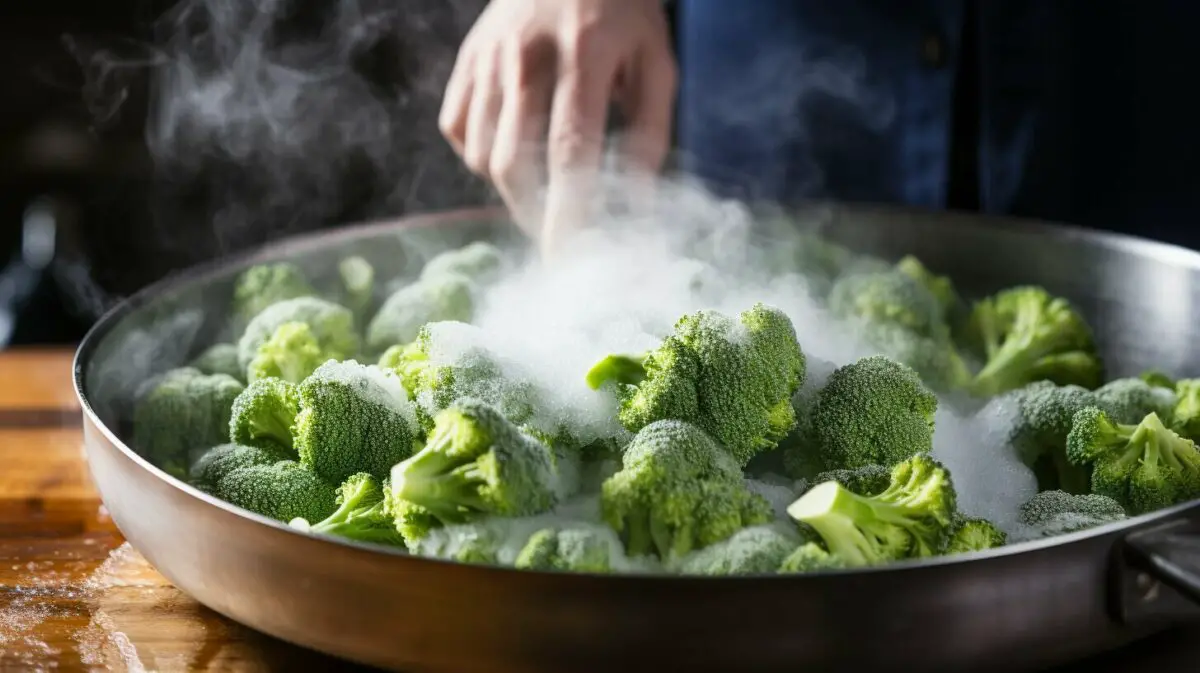
| Preparing Broccoli for Freezing | Blanching Broccoli | Cooking Frozen Broccoli |
|---|---|---|
| Wash the broccoli and cut it into florets | Boil the florets for 1-2 minutes | Cook for slightly less time than fresh broccoli |
| Save the broccoli stems for other recipes | Transfer the florets to ice water to cool | No need to thaw frozen broccoli before cooking |
| Pat the florets dry to remove excess moisture | Pat the florets dry after blanching | Freeze the broccoli for 1 hour on a baking sheet |
| Transfer the frozen broccoli to a freezer-safe bag | Store the frozen broccoli for 6-8 months | Cook frozen broccoli in various recipes |
Cutting Broccoli into Florets
When cutting broccoli into florets, aim for uniform pieces to ensure even cooking and freezing. This will help maintain the texture and flavor of the broccoli when it is eventually cooked or used in recipes. Start by removing the tough outer leaves from the broccoli head. Then, using a sharp knife, separate the florets from the stalk by cutting just below the head where the stalk meets the florets.
For smaller florets, cut the head into quarters and then separate each quarter into individual florets. If you prefer larger florets, simply cut the head into larger pieces. Remember to make clean cuts to avoid any unnecessary damage to the florets.

Broccoli Stem Usage
Don’t discard the broccoli stems! They can be used in various ways and are just as delicious as the florets. After removing the florets, peel the tough outer layer of the stem using a vegetable peeler. The inner part of the stem is tender and can be sliced or diced for use in stir-fries, soups, or salads. The stems can also be chopped and added to homemade vegetable broth for added flavor.
Broccoli Floret Size
The size of the broccoli florets can impact their cooking time and freezing process. Smaller florets tend to cook and freeze more quickly, while larger florets may require a bit more time. Aim for a consistent size when cutting the florets to ensure that they cook evenly and freeze uniformly.
| Floret Size | Cooking Time | Freezing Time |
|---|---|---|
| Small (bite-sized) | 2-3 minutes | 1 hour |
| Medium (1-2 inches) | 3-4 minutes | 1-2 hours |
| Large (2-3 inches) | 4-5 minutes | 2-3 hours |
By following these simple tips, you can ensure that your broccoli florets are cut to the right size and ready for cooking or freezing. Remember to utilize the stems and experiment with different recipes to make the most of this nutritious vegetable!
Blanching Broccoli
Blanching broccoli helps preserve its color, texture, and nutritional value, and it’s a simple process that guarantees better results when freezing. To blanch broccoli for freezing, follow these easy steps:
- Start by cutting the broccoli into florets, ensuring they are of similar size for even cooking.
- Bring a large pot of water to a boil, enough to fully submerge the broccoli florets.
- Add the broccoli florets to the boiling water and blanch for 1 to 2 minutes. Blanching time may vary depending on the size and maturity of the florets.
- While the broccoli is blanching, prepare an ice bath by filling a large bowl with cold water and ice cubes.
- Using a slotted spoon or tongs, transfer the blanched broccoli from the boiling water to the ice bath. This immediately stops the cooking process and helps preserve the vibrant green color.
- Allow the broccoli to sit in the ice bath for at least 2 minutes, or until completely cool.
- Once the broccoli is cool, remove it from the ice bath and drain off any excess water.
- Pat the broccoli dry using a clean kitchen towel or paper towel to remove any remaining moisture, as moisture can lead to freezer burn.
Now, your blanched and dried broccoli is ready for freezing. It’s best to freeze the florets in a single layer on a baking sheet for about an hour. This initial freezing step prevents the florets from sticking together and allows for easy portioning later on.

| Freezing Broccoli | Storage Time |
|---|---|
| -20°C / -4°F or below | 6 to 8 months |
After the initial freeze on the baking sheet, transfer the frozen broccoli to a sealable freezer-safe bag. Make sure to squeeze out all excess air before sealing the bag tightly. Properly stored, the frozen broccoli can maintain its quality for 6 to 8 months in the freezer. Remember to label the bag with the date for easy reference.
When using frozen broccoli in recipes, it’s not necessary to thaw it beforehand. Adding frozen broccoli directly to soups, stir-fries, or casseroles works perfectly fine. Just keep in mind to adjust the cooking time slightly less than what the recipe indicates for fresh broccoli to prevent overcooking. Enjoy the convenience of having nutritious broccoli available all year round!
Cooling and Drying Broccoli
Once you’ve blanched the broccoli florets, it’s essential to cool them down and remove excess moisture before freezing. Cooling blanched broccoli properly helps preserve its vibrant color, texture, and flavor. Excess moisture can lead to ice crystals forming on the surface of the broccoli, affecting its quality.
To cool the blanched broccoli, place the florets in a colander or strainer and rinse them under cold running water. This halts the cooking process and cools the broccoli quickly. Make sure to shake off any excess water and pat the florets dry with a clean kitchen towel or paper towel.
Drying the blanched broccoli thoroughly is crucial to prevent ice crystals from forming while freezing. Lay the cooled and dried florets in a single layer on a clean baking sheet. This allows air to circulate around the broccoli, ensuring even freezing. Place the baking sheet in the freezer for about an hour or until the florets are firm and slightly frozen.

Table: Cooling and Drying Broccoli
| Steps | Instructions |
|---|---|
| Cooling | Rinse blanched broccoli under cold running water to cool it down. |
| Drying | Pat the cooled broccoli dry with a clean kitchen towel or paper towel to remove excess moisture. |
| Freezing | Place dried broccoli florets in a single layer on a baking sheet and freeze for about an hour. |
Once the broccoli is frozen, transfer it to a sealable freezer-safe bag, remove any excess air, and seal it tightly. Label the bag with the date of freezing and use within 6 to 8 months for the best quality.
In summary, cooling and drying the blanched broccoli before freezing is essential to maintain its freshness and texture. By following these steps, you can ensure that your frozen broccoli remains in optimal condition for months to come.
Freezing Broccoli – How to Freeze Broccoli
Proper freezing techniques will help maintain the flavor, texture, and nutritional value of your broccoli during storage. To freeze broccoli, start by cutting it into florets. This ensures that each piece freezes evenly and cooks consistently later on. You can also use the broccoli stems, which are equally delicious and provide a nice crunch to your recipes.
Next, blanch the broccoli florets in boiling water for 1 to 2 minutes. This short blanching time helps preserve their vibrant green color and eliminates any bacteria present on the surface. After blanching, transfer the florets to a bowl of ice water to cool them quickly and stop the cooking process.
Once the florets are cool, pat them dry using a clean kitchen towel or paper towels. Excess moisture can lead to ice crystals forming during freezing, which may affect the quality of the broccoli. Spread the dried florets in a single layer on a baking sheet and freeze them for about an hour. Freezing them individually on the sheet prevents them from sticking together, making it easier to portion out later.
| Freezing Broccoli Step by Step |
|---|
| Cut broccoli into florets. |
| Blanch florets in boiling water for 1-2 minutes. |
| Rinse florets under cold water until cool. |
| Pat dry with a kitchen towel or paper towels. |
| Spread florets in a single layer on a baking sheet and freeze for 1 hour. |
| Transfer frozen broccoli to a sealable freezer-safe bag and freeze for 6-8 months. |
Finally, transfer the frozen florets into a sealable freezer-safe bag, remove any excess air, and seal it tightly. This extra step prevents freezer burn and extends the shelf life of your frozen broccoli. Store the bag in the freezer, and your broccoli will remain fresh and delicious for 6 to 8 months.
One of the great things about frozen broccoli is that it can be used straight from the freezer without thawing. Simply add it directly to your favorite recipes, whether it’s stir-fries, soups, casseroles, or even steamed as a side dish. When cooking frozen broccoli, it’s best to slightly reduce the recommended cooking time for fresh broccoli, as it has already been partially cooked during the blanching process.
With these simple steps, you can enjoy the benefits of frozen broccoli all year round, adding convenience and nutrition to your meals. So, the next time you have fresh broccoli on hand, don’t hesitate to freeze some for later use!
Freezing Broccoli Step by Step
- Cut broccoli into florets.
- Blanch florets in boiling water for 1-2 minutes.
- Rinse florets under cold water until cool.
- Pat dry with a kitchen towel or paper towels.
- Spread florets in a single layer on a baking sheet and freeze for 1 hour.
- Transfer frozen broccoli to a sealable freezer-safe bag and freeze for 6-8 months.

Frozen broccoli can be safely stored in the freezer for 6 to 8 months without a significant loss in quality. By properly freezing your broccoli, you can enjoy its freshness and nutrients even when it’s out of season. Understanding the storage times for frozen broccoli is essential to ensure that it remains delicious and nutritious for an extended period.
When freezing broccoli, it’s important to follow the recommended steps. Begin by cutting the broccoli into florets to ensure even freezing and cooking. Next, blanch the florets in boiling water for 1 to 2 minutes to help preserve their vibrant color and texture. After blanching, rinse the broccoli under cold water until cool to stop the cooking process. Pat the florets dry to remove excess moisture and prevent ice crystals from forming during freezing.
To freeze the broccoli, spread the florets in a single layer on a baking sheet and place it in the freezer for 1 hour. This initial freezing helps prevent the florets from sticking together. Once the florets are partially frozen, transfer them to a sealable freezer-safe bag or container. Label the bag with the date and contents, then return it to the freezer.
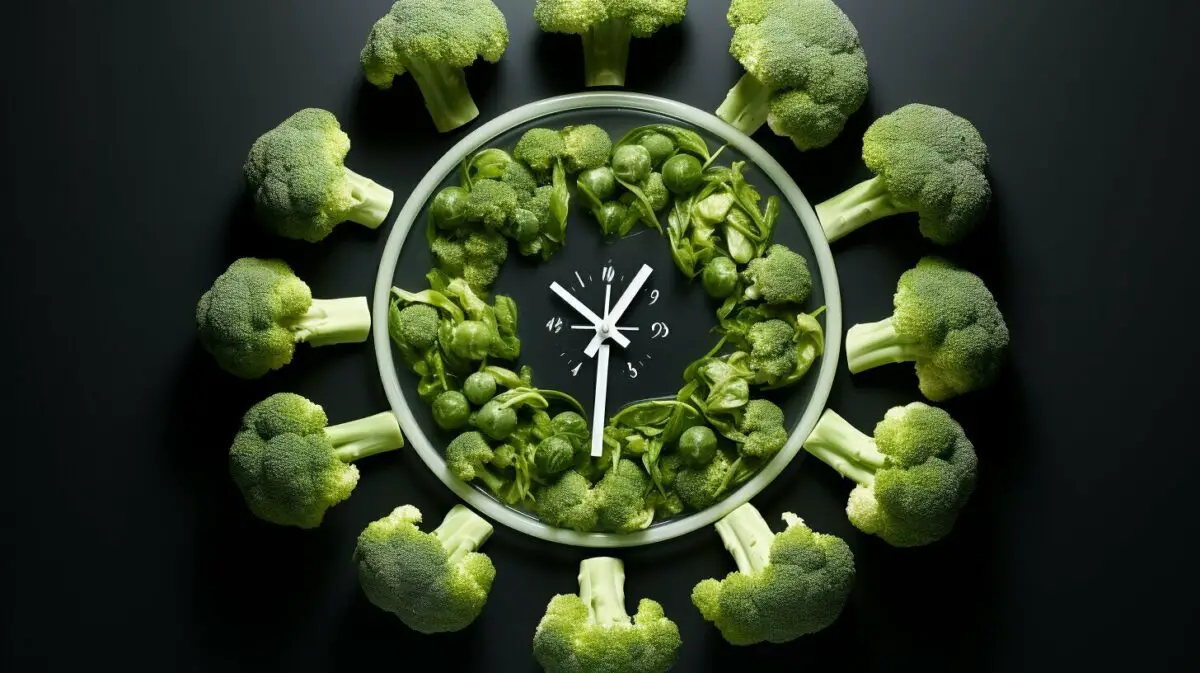
When using frozen broccoli in recipes, you can cook it slightly less than the recommended time for fresh broccoli. This will help maintain its texture and prevent it from becoming mushy. Keep in mind that frozen broccoli does not need to be thawed before cooking, making it a convenient and time-saving ingredient for various dishes.
By understanding the storage times for frozen broccoli and following the proper freezing techniques, you can enjoy the numerous health benefits of this versatile vegetable throughout the year. With its ability to be stored for 6 to 8 months without compromising quality, frozen broccoli is a convenient and nutritious addition to your freezer.
Using Frozen Broccoli in Recipes
Utilizing frozen broccoli in your favorite recipes is a time-saving and versatile way to incorporate this nutritious vegetable into your meals. Whether you’re whipping up a quick stir-fry, preparing a hearty casserole, or adding some greens to your soup, frozen broccoli can be a convenient option that doesn’t compromise on taste or quality.
When cooking with frozen broccoli, it’s important to follow a few simple guidelines to ensure the best results. Since frozen broccoli has already been blanched, there’s no need to thaw it before cooking. Simply add the frozen florets directly to your dishes, adjusting the cooking time slightly to accommodate for the already blanched state. Remember to cook the frozen broccoli slightly less than what the recipe indicates for fresh broccoli to prevent it from becoming overcooked.
Here are some ideas on how to use frozen broccoli in your recipes:
- Add frozen broccoli to pasta dishes like creamy Alfredo or zesty lemon garlic spaghetti for a burst of color and added nutrients.
- Incorporate frozen broccoli into your favorite casseroles, such as broccoli and cheese casserole or chicken and broccoli bake, for a comforting and filling meal.
- Create delicious stir-fries by sautéing frozen broccoli with other vegetables, protein like chicken or shrimp, and sauces like soy or teriyaki.
- Make flavorful soups by adding frozen broccoli to vegetable, chicken, or cream-based soups, enhancing both the taste and nutritional value of your soups.
Remember, frozen broccoli is a versatile ingredient that can be used in various cooked recipes without sacrificing flavor or quality. So go ahead and experiment with different dishes to discover new and exciting ways to enjoy the benefits of frozen broccoli in your everyday cooking.

| Recipe | Cooking Time |
|---|---|
| Broccoli and Cheese Casserole | 25 minutes |
| Chicken and Broccoli Stir-Fry | 15 minutes |
| Creamy Broccoli Soup | 30 minutes |
Cooking Frozen Broccoli
When cooking with frozen broccoli, it’s important to understand the adjustments needed to achieve the perfect texture and preserve its nutritional benefits. Frozen broccoli can be used directly in various cooked recipes, eliminating the need for thawing. Here are a few essential tips to help you make the most of your frozen broccoli.
- Cooking Times: Frozen broccoli typically requires slightly less cooking time compared to fresh broccoli. This is because the freezing and blanching process partially cooks the vegetable. To avoid overcooking, follow the cooking time recommendations provided below:
| Frozen Broccoli Cooking Method | Cooking Time |
|---|---|
| Boiling | 3-5 minutes |
| Steaming | 4-6 minutes |
| Sautéing/Stir-frying | 4-6 minutes |
To determine the ideal cooking time, start with the lower end of the recommended range and adjust accordingly based on your desired level of tenderness. Remember to monitor the broccoli closely while cooking to prevent it from becoming mushy.
Thawing frozen broccoli is not necessary when using it in recipes that involve cooking, as the heat will naturally thaw and cook the vegetable. However, if you prefer to thaw it beforehand, simply transfer the required amount of frozen broccoli to a colander and rinse it under cool water until thawed. Pat it dry before using. Thawed frozen broccoli may have a slightly softer texture and release some moisture, so adjust cooking times accordingly.
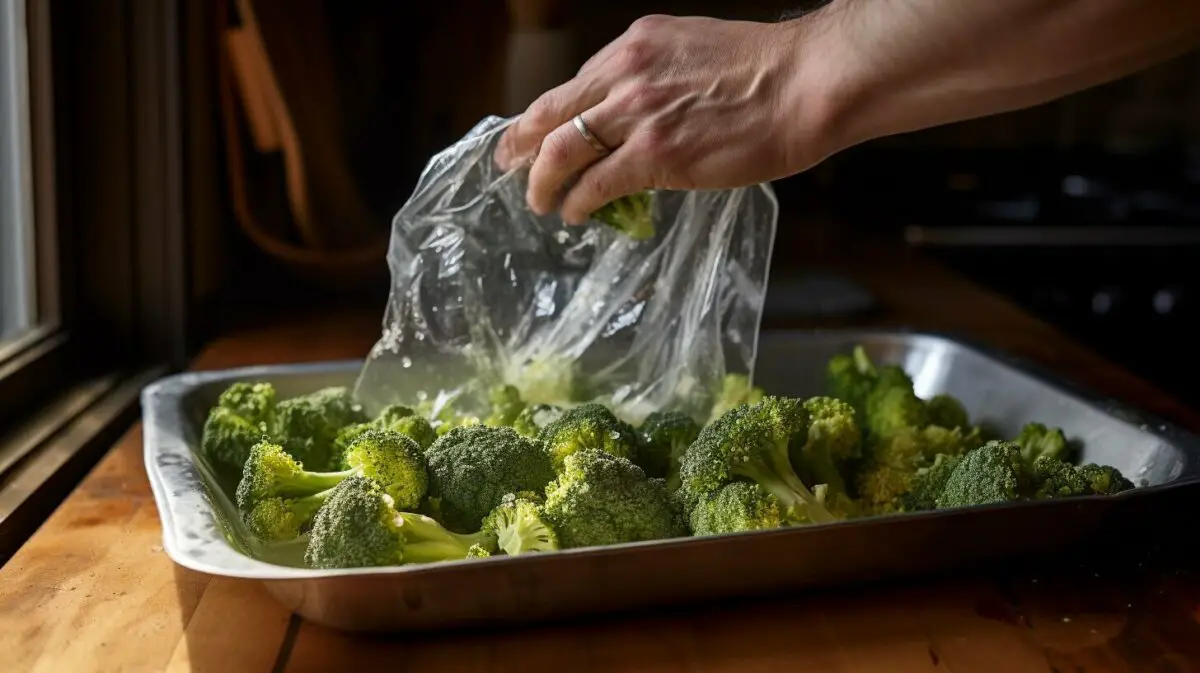
Frozen broccoli is a convenient ingredient that can be used to prepare a variety of delicious dishes. Here are a few recipe ideas to inspire you:
- Broccoli and Cheddar Quiche: Combine frozen broccoli with eggs, cheddar cheese, and spices to create a flavorful quiche for a hearty breakfast or brunch.
- Broccoli and Chicken Stir-fry: Sauté frozen broccoli florets with diced chicken, garlic, and soy sauce for a quick and healthy Asian-inspired meal.
- Broccoli Soup: Cook frozen broccoli with onions, vegetable broth, and herbs for a comforting and nutritious homemade soup.
Experiment with these recipes or incorporate frozen broccoli into your favorite dishes for added convenience and nutrition. Remember to adjust cooking times to achieve the desired texture and enjoy the benefits of frozen broccoli all year round!
Delicious Broccoli Recipes
Whether you’re craving a comforting soup, a flavorful casserole, or a vibrant side dish, these broccoli recipes are sure to satisfy your taste buds. Broccoli’s versatility makes it a fantastic ingredient for a variety of dishes, allowing you to explore different flavors and culinary styles.
1. Broccoli Soup
Warm up on a chilly day with a comforting bowl of broccoli soup. This creamy and nutritious soup is easy to make and packed with flavor. Simply sauté onions and garlic in a large pot, add chopped broccoli florets, and pour in vegetable or chicken broth. Let it simmer until the broccoli is tender, then puree the soup until smooth. Finish with a touch of cream or a sprinkle of grated cheese for added richness. Serve with crusty bread for a satisfying meal.
2. Broccoli Casserole
A broccoli casserole is a crowd-pleasing dish that can be a star at any gathering. Combine blanched broccoli with cooked rice, diced chicken or tofu, and a creamy sauce made with cheese, milk, and seasonings. Top it off with breadcrumbs or crushed crackers for a crispy and golden finish. Bake until bubbly and serve as a main course or a comforting side dish alongside roasted meats or grilled vegetables.
3. Broccoli Side Dish Recipes
Broccoli makes a delicious and nutritious side dish that pairs well with a variety of main courses. Steamed broccoli seasoned with a sprinkle of salt and a drizzle of lemon juice is a classic choice. For a twist, try sautéing broccoli with garlic and red pepper flakes for a flavorful kick. You can also toss roasted broccoli in a tangy balsamic glaze or sprinkle it with Parmesan cheese for added depth of flavor. Get creative and experiment with different herbs, spices, and sauces to elevate your broccoli side dish.
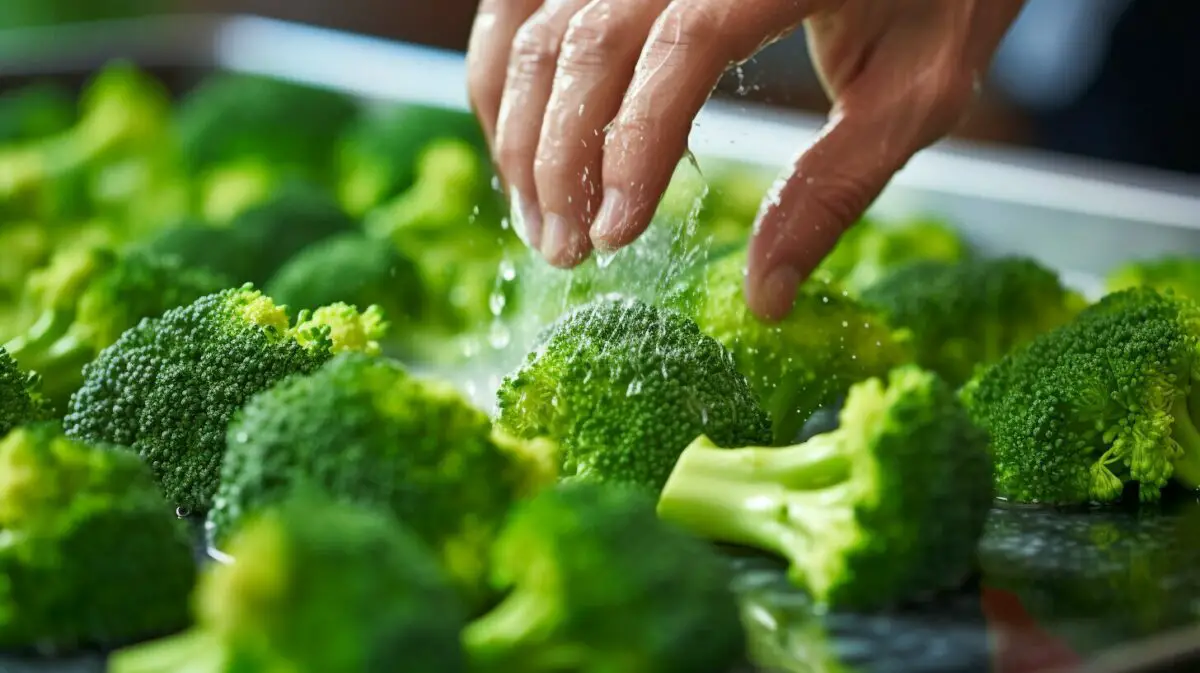
| Recipe | Prep Time | Cook Time | Servings |
|---|---|---|---|
| Broccoli Soup | 10 minutes | 30 minutes | 4 |
| Broccoli Casserole | 20 minutes | 45 minutes | 6 |
| Broccoli Side Dish | 15 minutes | 10 minutes | 4 |
“Broccoli is not only versatile and delicious, but it also provides a wealth of health benefits. Packed with vitamins, minerals, and antioxidants, it supports a strong immune system, promotes healthy digestion, and helps reduce the risk of chronic diseases. Incorporating broccoli into your meals is a great way to nourish your body and enjoy its incredible flavors.”
Experiment with these broccoli recipes and discover the endless possibilities this nutrient-rich vegetable offers. Whether you’re a soup lover, a casserole enthusiast, or a fan of vibrant side dishes, broccoli is sure to add a delicious and healthy touch to your meals.
Health Benefits of Broccoli
Including broccoli in your diet offers numerous health benefits due to its high levels of vitamins, minerals, and beneficial compounds. This cruciferous vegetable is not only low in calories but also packed with essential nutrients that can support overall well-being.
Broccoli is a rich source of vitamin C, which plays a crucial role in supporting a healthy immune system and promoting collagen production for healthy skin. It is also abundant in vitamin K, which aids in blood clotting and helps maintain strong bones.
Furthermore, broccoli contains high levels of antioxidants, including beta-carotene and selenium, which help protect the body against harmful free radicals and reduce the risk of chronic diseases such as heart disease and cancer. These antioxidants also contribute to maintaining healthy vision and promoting optimal brain function.
In addition to its vitamin and antioxidant content, broccoli is an excellent source of dietary fiber, which aids in digestion and promotes feelings of fullness. It also contains folate, which is vital for cell growth and development, making it particularly beneficial for pregnant women.
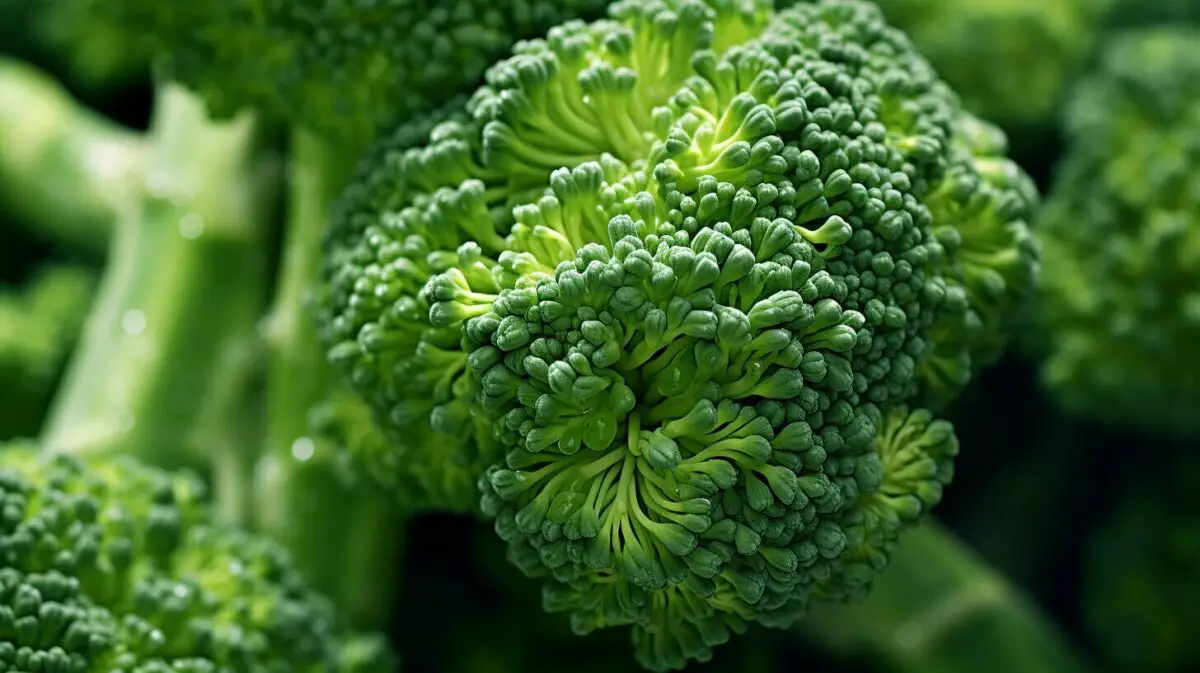
- Broccoli is packed with essential vitamins, minerals, and antioxidants.
- It is a rich source of vitamin C, which supports a healthy immune system.
- The high antioxidant content in broccoli helps protect against chronic diseases.
- Broccoli is an excellent source of dietary fiber, aiding in digestion and promoting feelings of fullness.
- It contains folate, which is important for cell growth and development, especially during pregnancy.
| Vitamin | Amount per 100g |
|---|---|
| Vitamin C | 89.2 mg |
| Vitamin K | 101.6 mcg |
| Folate | 63 mcg |
Broccoli is a nutritious powerhouse that offers a wide range of health benefits. From supporting a strong immune system to reducing the risk of chronic diseases, incorporating this versatile vegetable into your diet can help you maintain optimal health.
Raw Vs. Cooked Broccoli
Raw and cooked broccoli each provide distinct nutritional advantages, and understanding the differences can help you incorporate them into your diet effectively. While raw broccoli retains more of its natural nutrients, cooking broccoli can enhance certain compounds and make it easier for our bodies to absorb them. Let’s explore the nutritional benefits of both raw and cooked broccoli.
When it comes to raw broccoli, it is rich in vitamin C, an essential antioxidant that supports a healthy immune system and collagen production. Additionally, raw broccoli contains high levels of sulforaphane, a compound known for its cancer-fighting properties. By consuming raw broccoli, you can ensure you’re getting a good dose of these vital nutrients.
On the other hand, cooking broccoli can increase the availability of other nutrients, such as beta-carotene, an antioxidant that our bodies convert into vitamin A. Steaming or lightly sautéing broccoli can make it easier for our bodies to absorb this nutrient. Cooking broccoli also breaks down the tough fibers, making it more digestible and gentle on the digestive system.

| Nutrient | Raw Broccoli (per 100g) | Cooked Broccoli (per 100g) |
|---|---|---|
| Vitamin C | 89.2 mg | 51.7 mg |
| Vitamin A | 31.7 mcg | 120.7 mcg |
| Sulforaphane | Present | Present |
| Fiber | 2.6 g | 2.3 g |
“Eating a mix of raw and cooked broccoli can provide a wide range of nutrients and health benefits,” says nutritionist Jane Smith. “Including both in your diet allows you to enjoy the natural antioxidants and cancer-fighting compounds in raw broccoli, while also benefiting from the increased absorption of nutrients in cooked broccoli.”
Incorporating Raw and Cooked Broccoli
Now that you know the nutritional benefits of both raw and cooked broccoli, it’s time to incorporate them into your diet. Enjoy raw broccoli in fresh salads, as a crunchy snack with a dip, or blended into a nutritious green smoothie. Cooked broccoli can be added to stir-fries, roasted with other vegetables, or steamed as a side dish for your main meals.
Remember, whether you choose to consume broccoli raw or cooked, it’s important to include this cruciferous vegetable regularly in your diet. Its abundance of vitamins, minerals, and beneficial compounds make it a valuable addition to a healthy and balanced eating plan.
So, why not enjoy the best of both worlds by incorporating raw and cooked broccoli into your meals? Embrace the versatility and nutritional benefits of this remarkable vegetable, and savor the delicious and nourishing possibilities it offers.
Conclusion
Freezing broccoli allows you to enjoy this nutritious vegetable year-round while maintaining its flavor, texture, and essential nutrients. By following a simple step-by-step guide, you can easily freeze broccoli and preserve its freshness for months to come.
When freezing broccoli, it is important to cut it into uniform florets and blanch them briefly to retain their vibrant color and texture. After blanching, be sure to cool and dry the broccoli before transferring it to the freezer. Properly packaged, frozen broccoli can last for 6 to 8 months without compromising its quality.
One of the great advantages of frozen broccoli is its versatility in cooking. It can be used in a wide variety of recipes, from stir-fries and soups to casseroles and side dishes. When using frozen broccoli in recipes, it is best to cook it slightly less than the recommended cooking time for fresh broccoli.
Unlike many other frozen vegetables, frozen broccoli does not need to be thawed before cooking. Simply add it directly to your favorite recipes, and it will thaw and cook simultaneously. This makes frozen broccoli a convenient and time-saving ingredient for quick and nutritious meals.
FAQ
Q: How do I freeze broccoli?
A: To freeze broccoli, start by cutting it into florets. Then, blanch the florets in boiling water for 1 to 2 minutes and rinse them under cold water until cool. Pat the broccoli dry, place it in a single layer on a baking sheet, and freeze for 1 hour. Finally, transfer the frozen broccoli to a sealable freezer-safe bag and freeze for 6 to 8 months. When using frozen broccoli in recipes, cook it slightly less than the recipe indicates for fresh broccoli. Frozen broccoli can be used in various cooked recipes and does not need to be thawed before cooking.
Q: Why should I freeze broccoli?
A: Freezing broccoli allows you to preserve your fresh produce and have access to this healthy vegetable, even when it’s out of season.
Q: How do I prepare broccoli for freezing?
A: To prepare broccoli for freezing, cut it into florets and blanch them in boiling water before rinsing under cold water until cool.
Q: How do I cut broccoli into florets?
A: To cut broccoli into florets, remove the stems and cut the head into small, bite-sized pieces.
Q: How long do I need to blanch broccoli for freezing?
A: Blanch broccoli in boiling water for 1 to 2 minutes to preserve its color, texture, and flavor.
Q: How do I cool and dry blanched broccoli?
A: After blanching broccoli, cool it by rinsing under cold water and pat it dry before freezing.
Q: How should I freeze broccoli?
A: After drying the blanched broccoli, place it in a single layer on a baking sheet and freeze for 1 hour. Then, transfer the frozen broccoli to a sealable freezer-safe bag and freeze for 6 to 8 months.
Q: How long can I store frozen broccoli?
A: Frozen broccoli can be stored in the freezer for 6 to 8 months without compromising its quality.
Q: Can I use frozen broccoli in recipes?
A: Yes, frozen broccoli can be used in various cooked recipes without needing to be thawed before cooking.
Q: How do I cook frozen broccoli?
A: When using frozen broccoli in recipes, cook it slightly less than the recipe indicates for fresh broccoli to prevent overcooking.
Q: What are some delicious recipes I can make with broccoli?
A: Broccoli can be used in recipes such as broccoli soup, broccoli casserole, and various side dishes. The possibilities are endless!
Q: What are the health benefits of broccoli?
A: Broccoli is a nutritional powerhouse, packed with essential vitamins, minerals, and antioxidants that support overall health and well-being.
Q: Is raw or cooked broccoli better?
A: Both raw and cooked broccoli have their own unique attributes and nutritional profiles. Cooking broccoli can change its texture and taste, but it can also enhance its digestibility and nutrient absorption.
Q: Can I freeze other vegetables using the same method?
A: Yes, you can use a similar method to freeze other vegetables like cauliflower, carrots, and green beans.
Source Links
https://nchfp.uga.edu/how/freeze/broccoli.html
Related Recipes:
 How to Freeze Bananas? (Perfect Step-By-Step Guide)
How to Freeze Bananas? (Perfect Step-By-Step Guide)
 How to Freeze Avocados? (Perfect Step-By-Step Guide)
How to Freeze Avocados? (Perfect Step-By-Step Guide)
 How to Freeze Spinach? (Perfect Step-By-Step Guide)
How to Freeze Spinach? (Perfect Step-By-Step Guide)
 How To Freeze Rhubarb (Perfect For Long Term Storage)
How To Freeze Rhubarb (Perfect For Long Term Storage)
 How to Freeze Oranges: Keep Citrus Fresh for Longer
How to Freeze Oranges: Keep Citrus Fresh for Longer
 How to Freeze Passion Fruit? (Step-By-Step Guide)
How to Freeze Passion Fruit? (Step-By-Step Guide)
 How to Store Parsley? (Perfect Every Time!)
How to Store Parsley? (Perfect Every Time!)
 Chinese Broccoli
Chinese Broccoli


